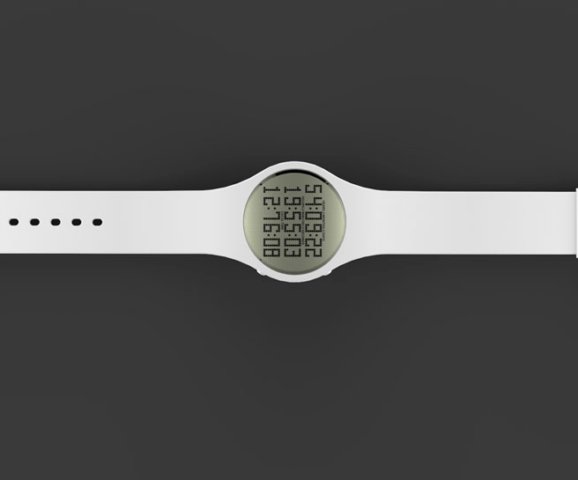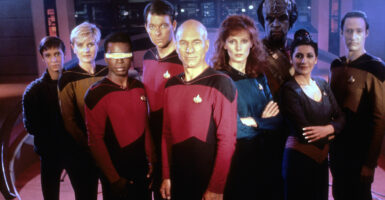Smartwatch Counts Down To The Seconds To Your Death
This article is more than 2 years old
 The average life expectancy for an American is 79.8 years, which ranks 33rd on a list of the world’s countries. The Japanese have the highest life expectancy, at 84.6 years. Must be the steady diet of soy and anime. And if you’re one of those people who wants to know even more specifically how long you might live, there are a bunch of life expectancy calculators out there that take into account everything from flossing habits to workload to exposure to second-hand smoke. According to one of those calculations, I can expect to live until 90. On the one hand, that’s a nice high number, and probably more comforting than if the site told me I’d live to be 60. On the other hand, I don’t want to become falsely confident in my resiliency, nor do I want to believe that if I don’t live to 90, I’ve somehow screwed something up. Even though there are no sure bets—I could get abducted by aliens tomorrow or end up with bio-printed organs and tissues that allow me to live to 200—some people get pretty consumed with calculating their life expectancy, particularly as it relates to earning potential and retirement savings. For those folks, there’s now a smartwatch that predicts the exact time one will meet his maker.
The average life expectancy for an American is 79.8 years, which ranks 33rd on a list of the world’s countries. The Japanese have the highest life expectancy, at 84.6 years. Must be the steady diet of soy and anime. And if you’re one of those people who wants to know even more specifically how long you might live, there are a bunch of life expectancy calculators out there that take into account everything from flossing habits to workload to exposure to second-hand smoke. According to one of those calculations, I can expect to live until 90. On the one hand, that’s a nice high number, and probably more comforting than if the site told me I’d live to be 60. On the other hand, I don’t want to become falsely confident in my resiliency, nor do I want to believe that if I don’t live to 90, I’ve somehow screwed something up. Even though there are no sure bets—I could get abducted by aliens tomorrow or end up with bio-printed organs and tissues that allow me to live to 200—some people get pretty consumed with calculating their life expectancy, particularly as it relates to earning potential and retirement savings. For those folks, there’s now a smartwatch that predicts the exact time one will meet his maker.
On its website, Tikker is hilariously called “the happiness watch” and “the death watch.” I guess they’re one in the same? At least that’s what Tikker’s makers want us to think. They acknowledge that such a watch might “seem depressing,” but they also point out that in order to make the most of life, one has to truly savor and appreciate every single second you have. Thus, the Tikker, which counts up exactly how many seconds that is.
“Anger or forgiveness? Tic-toc. Wearing a frown or a smile? Tic-toc. Happy or upset? Tic-toc.” So that sounds just a little like a cult, although the basic premise is a good one. I do think the assertion that “Wearing a Tikker is a statement to the world that your biggest priority in life, is living,” is quite an assumption. I could see hypochondriacs becoming unhealthily obsessed with the countdown. “While death is nonnegotiable, life isn’t. The good news is that life is what you make of it – and it can be beautiful!” Absolutely. Although if you’re checking your damn death watch every five seconds to see if that piece of cake or shot of tequila just took minutes off your life, I’m not sure that counts as making the most of it.
The watch’s maker, Swedish writer Fredrik Colting,, is sometimes better known by his pseudonym John David California—that’s the name he used to write the book 60 Years Later: Coming Through the Rye, which was banned in North America after losing a copyright battle with J.D. Salinger. Colting worked as a gravedigger in Sweden, which undoubtedly sparked his interest in death. Or life. Or watches.
As watches go, this one is pretty simple: it’s got three rows that show the years, months, days, hours, minutes, and seconds until death. And then it shows the time. It reminds me of Continuum’s Halo, or the digital clock from In Time. Except, y’know, hopefully it doesn’t kill the wearer or make him go crazy.
The watch was funded on Kickstarter, where over 2,000 backers pledged monetary support. When one gets the watch, one fills out a questionnaire to figure out his or her life expectancy, subtracts one’s current age, and then the countdown starts from there. There aren’t any on-the-fly calculations, which seems to be a fairly major oversight. What if I quit or take up smoking? What if I stop riding my bike to work? What if I become a professional skydiver? But in the meantime, “it’s not really about how much time you HAVE, it’s what you DO with it.” Hear hear.












